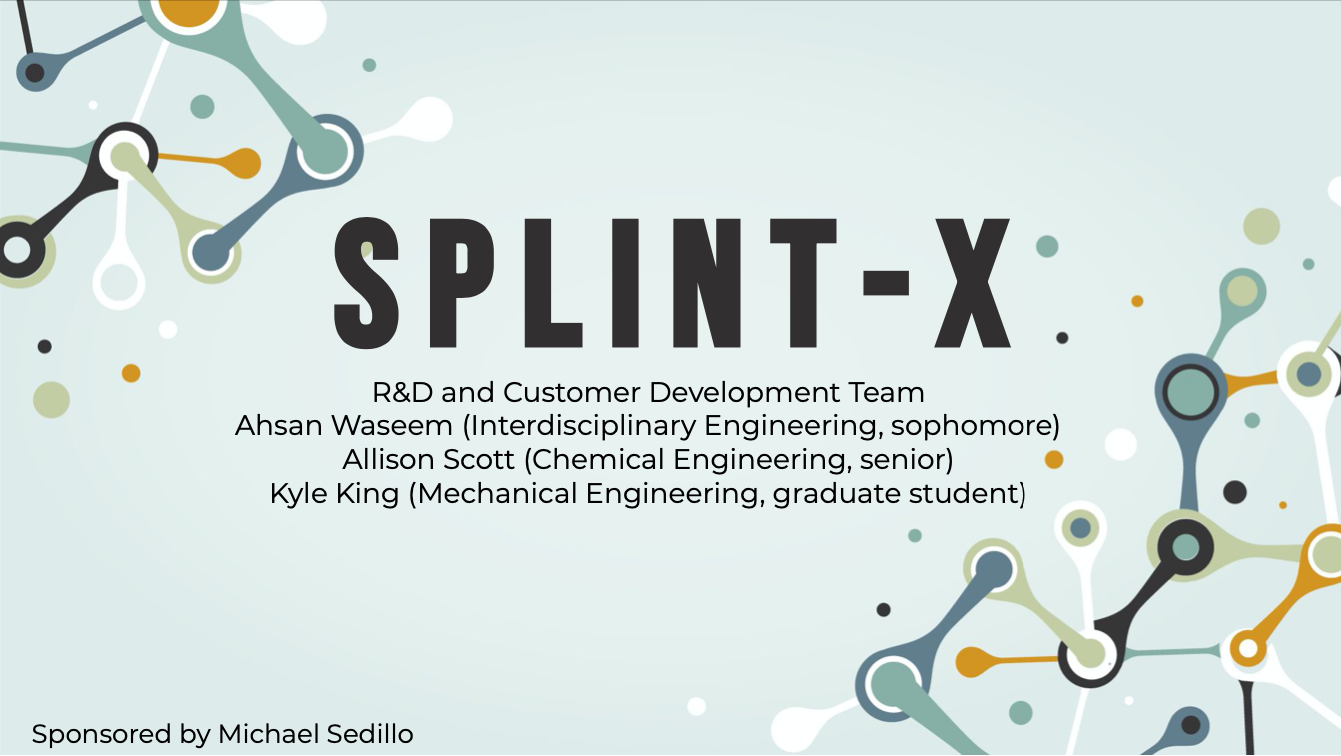Team Splint-X
Team Splint-X
Texas A&M University
“A Splint in a Can” - Helping Ejected Aircrew Quickly Address Injuries and Evade Hostile Environments
The Team
Kyle King
• MS in Mechanical Engineering and Graduate Research Assistant at Texas A&M University
• BE in Mechanical Engineering at Bradley University
• Graduate Research Assistant at Texas A&M University
Allison Scott
• BS in Chemical Engineering at Texas A&M University
Ahsan Waseem
• BS in Interdisciplinary Studies - Electronic Systems and Industrial Distributions Engineering at Texas A&M University
• Former Sound Engineering Intern at Lucky Run Studios
Problem Sponsor
Air Force Research Laboratory
Original Problem Statement
Ejected Aircrew members need a compact way to stabilize a broken limb while enabling mobility to allow the injured aircrew to escape and evade until rescued.
Beneficiary Discovery Interviews
52
The Innovation
Each year, roughly 10 fighter pilots must eject from their aircraft, and breaking a limb upon ejection or landing is not an uncommon occurrence. Currently, there are no splint type devices within the survival aid kit of a fighter jet. Fighter pilots who need a quick and easy way to become mobile to evade hostile environments turn to sticks or other resources they are able to find upon landing.
Team Splint-X was tasked with addressing this challenge and spoke with over fifty Air Force members, nurses, EMTs, and researchers to identify a viable solution. Initially the team struggled to identify a solution but with a combination of speaking to people and research, they began to recognize what the customer needed. They realized they needed to identify a splint solution that required little to no training to use, was small enough to fit into ejection kits, and something that would allow for quick mobility.
As the team continued their interviews, they realized that this was a big need within the Air Force and their unique position to help these soldiers. Team Splint-X created a splint device that utilizes quick hardening foam to be sprayed on the injured area creating a durable, temporary cast in order to become mobile and prevent any further injury. After looking at competitors, they realized there was nothing as compact and fast acting currently on the market. In addition to ejected Aircrew, the team has identified a variety of other potential beneficiaries: emergency medical personnel, hikers, athletes, and animal care professionals.
The team has received very positive feedback from both their sponsor and other beneficiaries on this much needed product. While health conditions limited site visits, lab time, and the ability to physically “get out of the building”, Team Splint-X adapted. Ahsan says “There are a lot of obstacles in entrepreneurship, and the pandemic is just one of them.” Their tenacity has allowed them to successfully develop a proof concept and establish plans to continue their work beyond the semester.
With the high-potential of this product, the team received a grant from the vector program at A&M University to continue with their work. With this grant, the team plans to create a product prototype. Once they accomplish a successful prototype, they hope to start a company, pursue a patent and seek further funding to develop their project. Their ultimate goal is to conduct a clinical trial and go through the FDA approval process so they can begin implementation of their multi-use solution across a wide range of industries.
Presentation
Team Splint-X’s
Hacking for Defense Experience
Career Impact
For Kyle King, getting into the vector program was a “dream come true”. Having his own businesses has been a dream of his and he hopes to pursue this work full time after graduation. He says the progression of his H4D project is “a step in the right direction for what I've always wanted to do.” Similarly, Ahsan shared that his experience in Hacking for Defense strengthened his goal of starting his own company. He really enjoyed the idea and process of “starting something from nothing.”
For Allison, she realized how much she enjoyed working with people and the problem solving process. Brainstorming ideas with beneficiaries and watching their ideas, shift, fall or become something totally different was a very rewarding process. This experience has piqued her interest in the technical consulting world, where she is able to bring her knowledge to clients to help solve their problems.
Building a Network to Reach Their Solution
For Ahsan, speaking with 50 beneficiaries was simultaneously the most challenging and most rewarding aspect of the course. He described the frustration of finding someone they are really interested in talking to, but then not hearing back from them. The course has made him “More comfortable reaching out to people and cold emailing.” Overall, the team was pleasantly surprised by how willing people were to speak with them. Kyle shared “They were strangers to us, but they were incredibly helpful and wanted to stay in contact with us.”
The team also points to their H4D teaching team as a key driver of their success. The teaching team always encouraged the team to (virtually) get outside of the classroom and the building to gain a better perspective on their problem. Their instructors helped the team understand the interview process and how to ask the right questions with beneficiaries. On behalf of the team, Allison expressed her gratitude for the teaching team. “They did a wonderful job leading us.”





